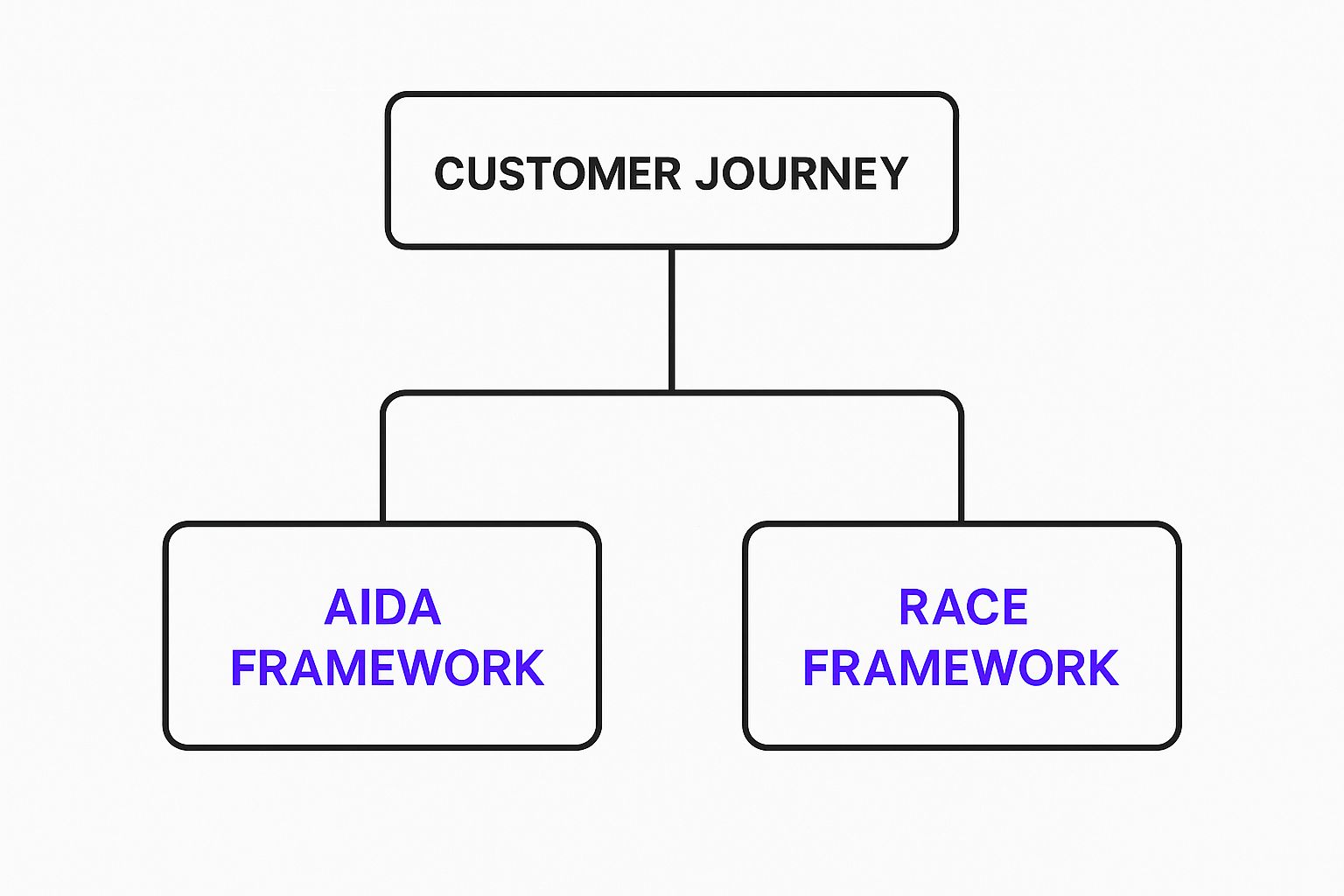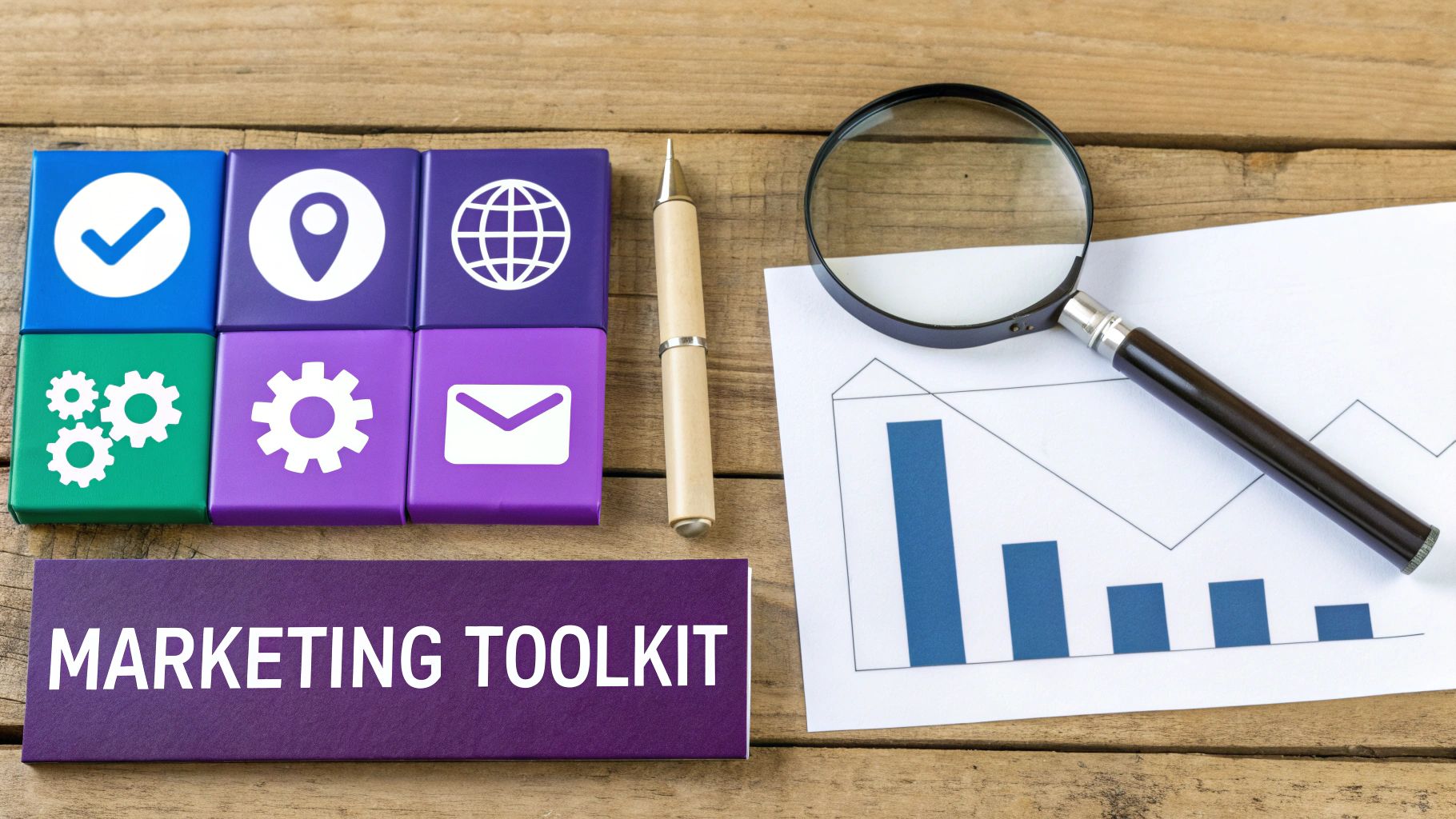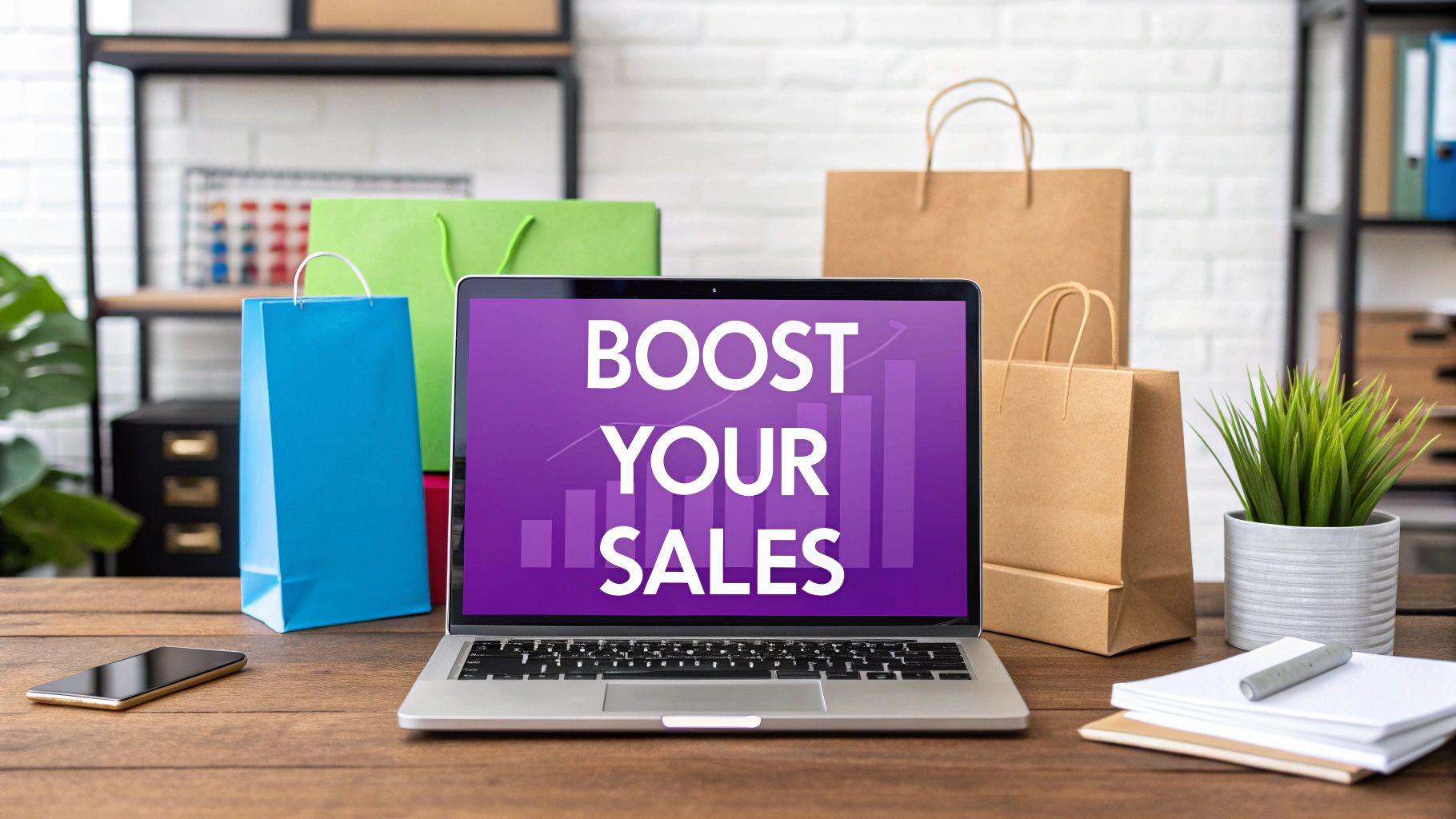Effective Marketing Strategy in E-Commerce: Boost Your Sales
Think of an e-commerce marketing strategy as the grand playbook for your online store. It's the master plan that connects all your efforts to find new customers, convince them to buy, and keep them coming back. This isn't just about randomly boosting posts or running a few ads; it's a deliberate, thoughtful approach ensuring every single dollar and minute you spend has a clear purpose.
Why an E-Commerce Marketing Strategy Is Your North Star

Trying to run an online store without a marketing strategy is like setting sail across the ocean without a map or a compass. You might float around for a bit and maybe even bump into an island of sales by pure luck, but you have zero control over where you're headed.
A solid strategy is the rudder on your ship. It lets you steer with intention through the ridiculously crowded digital marketplace, navigating directly toward your goals. It’s the critical link between a big-picture ambition—say, increasing revenue by 25% this year—and the concrete, on-the-ground actions you take, like launching a targeted ad campaign on Instagram or overhauling your product pages for better SEO.
The Foundation for Purposeful Growth
Without this guiding document, marketing quickly devolves into a chaotic mess of random, reactive tactics. You end up throwing money at ads without really knowing who you’re trying to reach or creating content that completely misses the mark with your ideal buyer.
A proper strategy forces you to stop and answer the tough, foundational questions first:
- Who are we actually selling to? This means getting granular with buyer personas to understand their pain points, what makes them tick, and where they hang out online.
- What makes us different from the other ten guys selling the same thing? Nailing your unique selling proposition (USP) is how you stop competing on price alone.
- How will we know if any of this is working? You have to establish clear Key Performance Indicators (KPIs) from the start so you can track progress and prove your marketing is worth the investment.
An e-commerce marketing strategy isn't some dusty document you create once and file away. It's a living, breathing guide that should evolve with market trends, customer feedback, and your own business performance. It’s what keeps you sharp and competitive.
Navigating an Expanding Digital Ocean
Let's be real: having a coherent strategy is more critical now than ever before. The global e-commerce market is absolutely exploding, with sales projected to smash $7.5 trillion by 2025. That growth shows just how ingrained online shopping has become for billions of people worldwide. (You can dig into more of these digital commerce statistics on cimulate.ai.)
But with that massive opportunity comes ferocious competition. A clear, well-executed marketing strategy is what separates the online stores that thrive from the ones that just get lost in the digital noise. It ensures your budget, your time, and your creative energy are all pointed in the same direction: driving sustainable, long-term growth.
Mapping the Customer Journey with Proven Frameworks
An e-commerce marketing strategy that actually works doesn’t just throw random tactics at the wall, hoping something sticks. That's a recipe for burning cash. Instead, it carefully guides a potential buyer from their first "who are you?" moment all the way to becoming a loyal, repeat customer who tells their friends.
To pull this off, savvy marketers rely on proven frameworks that map out this customer journey. Think of them as a GPS, ensuring every ad, email, and social media post has a specific job to do.
These frameworks are like storytelling guides. They help you get inside a customer's head at each stage, so you can deliver the right message at exactly the right time. Let’s break down two of the most powerful models out there: AIDA and RACE.
The AIDA Framework Unpacked
AIDA is a classic for a reason. It outlines the four mental stages a person moves through during the buying process, giving you a simple, linear path from discovery to purchase.
- Awareness: This is the "hello, we exist!" stage. A potential customer stumbles upon your brand for the first time. Maybe it's through a compelling social media ad, a blog post they found on Google, or a shout-out from an influencer they trust.
- Interest: Okay, you’ve got their attention. Now you have to hold it. In this stage, the person is actively clicking around, reading product descriptions, and maybe even comparing your stuff to the competition. They're curious.
- Desire: This is where the magic happens. Casual interest turns into a genuine "I want that." The customer starts picturing the product in their life. This shift is often sparked by emotional drivers—think glowing reviews, powerful customer testimonials, or case studies showing how you solved a problem for someone just like them.
- Action: This is the moment of truth—the final step where the customer pulls out their credit card. Your job is to make this as frictionless as possible. We're talking a big, obvious call-to-action (CTA), a simple checkout process, and reassuring trust signals like security badges and clear return policies.
This infographic breaks down how these foundational frameworks give structure to your entire customer journey.

As you can see, both AIDA and RACE provide a high-level structure to organize all your marketing activities around the customer's actual experience.
To make this even more concrete, here’s how you can apply the AIDA model to your e-commerce marketing plan.
Applying the AIDA Framework to E-Commerce Marketing
| Awareness | Introduce your brand to a cold audience. | Run targeted Facebook/Instagram ads, collaborate with influencers, publish SEO-optimized blog content, or get featured in gift guides. |
|---|---|---|
| Interest | Nurture initial curiosity and provide value. | Create detailed product pages with high-quality images/videos, send informative email newsletters, or retarget visitors with helpful content. |
| Desire | Build an emotional connection and create a strong want. | Showcase user-generated content (UGC), display social proof like reviews and testimonials, or send cart abandonment emails with a small incentive. |
| Action | Make it easy and compelling to buy. | Optimize your checkout process for mobile, offer multiple payment options, use clear calls-to-action ("Buy Now"), and display trust badges. |
By mapping your tactics to each stage, you ensure you're not asking for the sale before you've even earned their interest.
From a Single Sale to a Loyal Advocate with the RACE Model
While AIDA is fantastic for mapping the path to a first purchase, the RACE framework gives you a more cyclical view that’s all about building long-term customer relationships. It helps you see marketing as a continuous loop, not a one-and-done event.
The RACE model breaks down into four stages:
Reach: This is a lot like Awareness in AIDA. The goal here is to drive traffic to your website and social channels using things like SEO, paid ads, and social media marketing.
Act: This stage is all about encouraging interaction. You're persuading visitors to take that next small step—like subscribing to your newsletter, downloading a guide, or following you on social media.
Convert: This is where the sale happens. You successfully turn an interested prospect into a paying customer. Cha-ching.
Engage: This final stage is absolutely crucial. It’s all about building loyalty and turning one-time buyers into repeat customers and brand advocates through amazing post-purchase experiences and ongoing communication.
By focusing on the Engage stage, the RACE model shifts your perspective from just acquiring customers to actually nurturing them over their entire lifetime with your brand. This approach is the bedrock of a sustainable e-commerce business.
This focus on the entire customer lifecycle is a non-negotiable part of a modern e-commerce marketing strategy. To go even deeper, check out our guide on life cycle marketing to learn how to nurture those relationships for lasting growth. By mapping these journeys, you bring order to the chaos and ensure your marketing efforts work together to build a powerful, profitable brand.
Picking the Right Tools for Your Marketing Toolkit

A brilliant strategy is only as good as the tools you use to actually pull it off. Think of your marketing strategy in e commerce as a detailed blueprint for a house. Great. Now you have to actually build the thing. That means opening your toolkit and grabbing the right gear for each part of the job.
You wouldn't use a sledgehammer to hang a picture frame, right? And you definitely wouldn't use a tiny screwdriver to frame a support wall.
Each marketing channel is a specialized tool with a very specific purpose. The secret to success is knowing which tool to grab for which task—and how to make them all work together to build something that lasts. Let's break down the essential channels you need in your e-commerce toolkit.
SEO: The Concrete Foundation
Search Engine Optimization (SEO) isn't about stuffing keywords onto a page anymore. Think of SEO as the literal foundation of your entire e-commerce store. It’s the slow, methodical work that provides long-term stability and strength, making sure your business can be found by people who are actively looking for what you sell.
A solid SEO strategy means your product page for "sustainable trail running shoes" shows up on Google when a potential customer searches for exactly that. This isn't a paid ad; it's an earned spot. You've proven to Google that your page is the most relevant, authoritative result out there.
SEO is a long-game investment in visibility. It won't deliver results overnight, but the organic traffic it generates is often higher quality and more sustainable than any other channel. It’s absolutely indispensable.
While it takes time to see the needle move, a well-executed SEO plan will keep attracting qualified visitors for months, even years. It’s the ultimate play for building brand authority and driving consistent, cost-effective traffic.
PPC: The Power Drill for Instant Impact
If SEO is the slow-curing foundation, Pay-Per-Click (PPC) advertising is your power drill. It’s the tool you grab when you need to drive immediate, targeted action. Right now. Whether it's through Google Ads or social platforms like Facebook and Instagram, PPC lets you put your products in front of a hyper-specific audience, instantly.
Want to target 30-to-45-year-old men in California who have shown interest in cycling? PPC can do that. Need to blast a flash sale to people who visited your site but bailed at checkout? PPC retargeting is the perfect tool for the job.
Popular PPC Channels for E-Commerce:
- Google Shopping Ads: These visual ads are clutch. They show your product image, price, and store name right in the search results, grabbing high-intent buyers the moment they're ready to pull the trigger.
- Facebook & Instagram Ads: Perfect for generating demand and reaching audiences based on interests, behaviors, and demographics. You can use them for everything from top-of-funnel awareness to bottom-funnel "buy now" pushes.
- Search Ads: The classic text-based ads at the top of Google. They're all about targeting users based on the specific keywords they’re typing into the search bar.
PPC gives you priceless data and quick feedback, letting you test offers, messaging, and product positioning on the fly.
Email Marketing: The Relationship Builder
Email marketing is the most personal and direct tool in your entire kit. This is how you nurture relationships with customers who've already raised their hands and shown interest in your brand. It’s how you turn a one-time buyer into a lifelong fan.
With email, you can slice and dice your audience into segments and send highly relevant messages that build trust and drive repeat business.
Essential Email Campaigns for E-Commerce:
The Welcome Series: Greet new subscribers, tell them your brand's story, and maybe offer a small discount to get that first purchase over the line.
Abandoned Cart Reminders: A study shows that nearly 70% of online shopping carts are abandoned. Yikes. A timely, well-crafted email can recover a huge chunk of that lost revenue.
Post-Purchase Follow-ups: Send order confirmations, shipping updates, and requests for reviews. This builds confidence and shows you care about the customer experience long after the sale is made.
Promotional Campaigns: Announce new products, special offers, and seasonal sales to the people who are most likely to buy—your existing list.
Email marketing consistently delivers one of the highest ROIs of any channel because you’re talking to a warm audience that wants to hear from you. Nailing these campaigns is critical, and you can get an edge by exploring some of the best conversion rate optimization tools available to help refine your approach.
Content Marketing: The Trust Multiplier
Content marketing—your blog posts, videos, guides, and infographics—is the tool you use to establish expertise and build unshakable trust. It answers your customers' questions, solves their problems, and shows that you're an authority in your space.
Instead of just shouting "Buy my stuff!", content marketing says, "Hey, let me help you make an informed decision." A company selling high-end kitchen knives could create blog posts on "How to Properly Sharpen a Chef's Knife" or produce a video series on basic knife skills.
This kind of helpful content attracts the right audience and builds a positive feeling around your brand long before a purchase is ever considered. Plus, it seamlessly feeds your SEO efforts, creating a powerful loop that drives organic growth and positions you as the go-to resource in your industry.
Powering Growth with Personalization and Automation
In a world overflowing with online stores, a generic, one-size-fits-all marketing message is the fastest way to get ignored. Today’s shoppers don’t just appreciate a personal touch; they flat-out expect it. They want to feel like a brand actually gets their unique needs, tastes, and browsing habits.
This isn't a luxury for e-commerce giants anymore—it’s a core part of a winning marketing strategy in e commerce for brands of any size. It's about ditching the bullhorn and starting thousands of individual conversations at once.
So, how do you create these one-on-one experiences without an army of marketers? The answer is a powerhouse duo: smart personalization and slick marketing automation.
Making Every Customer Feel Seen
Personalization is the art of using customer data to make the shopping experience feel like it was built just for them. It’s about tweaking your website, emails, and ads so they resonate with the person on the other side of the screen.
Think of it like walking into your favorite local coffee shop. The barista knows your name, remembers your usual order, and might even ask how that project you mentioned last week is going. That experience makes you feel valued and keeps you coming back. Online personalization aims for that exact same feeling.
To pull this off, you need to understand what your customers are doing:
- Browsing History: What products have they been eyeing?
- Purchase Data: What have they bought before?
- Demographic Info: Where in the world are they?
- On-Site Actions: Did they ditch a cart or search for something specific?
Looking for some real-world inspiration? Checking out some top e-commerce personalization examples can spark some seriously effective ideas.
The Engine That Makes It All Scale: Automation
This is where marketing automation swoops in to save the day. It’s the tech that takes all that rich customer data and puts it to work for you, automatically. Automation platforms handle the repetitive, mind-numbing tasks, freeing you up to think about the big picture.
Instead of manually emailing every single person who abandons their cart, you set up an automated workflow that handles it. This system can send a perfectly timed reminder, a follow-up with similar products, or even a small discount to nudge them over the finish line.
By automating personalized messages at key moments, you can nurture leads, rescue lost sales, and build loyalty 24/7—without lifting a finger for each interaction.
This combination allows even small e-commerce teams to deliver the kind of sophisticated, one-to-one experiences that used to be reserved for corporations with massive budgets. To squeeze every drop of value from these systems, you need to stick to some proven guidelines. You can dive deeper into those with our guide on marketing automation best practices.
Real-World Plays That Actually Drive Results
So, what does this look like in practice? It’s all about creating dynamic experiences that adapt to each user, building a powerful connection that fuels both loyalty and revenue.
Here are a few tactics you can put into play right away:
Dynamic Product Recommendations: Show products on your homepage or product pages based on what a user was just looking at. If they were checking out running shoes, don't show them hiking boots. Simple, but it works.
Personalized Email Offers: Slice up your email list to send special promos based on purchase history. A customer who frequently buys coffee beans might get an exclusive offer on a new dark roast you just launched.
Behavior-Triggered Workflows: Automatically send a "welcome" series to new subscribers, cart abandonment reminders to shoppers with full carts, or "we miss you" campaigns to customers who haven't purchased in a while.
This level of relevance pays off, big time. Companies that nail personalization consistently blow past their revenue targets because customers who feel understood by a brand simply buy more. In fact, 56% of marketing leaders are actively pouring money into these technologies because they see a direct line to their bottom line.
Ultimately, merging personalization with automation isn’t just another tactic; it’s a fundamental shift in how you build relationships and power sustainable growth.
Turning Social Media into a Sales Engine

Social media isn't just for brand awareness and cat videos anymore. Let's be real—it's become a massive digital mall where people discover and buy products without ever leaving the apps they scroll through daily. This is social commerce, and it's turned platforms like Instagram, TikTok, and Facebook into honest-to-goodness storefronts.
A modern marketing strategy in e commerce has to see these channels for what they are: direct revenue drivers, not just content billboards. The game is to shrink the distance between "Ooh, I want that" and "Purchase complete," creating a frictionless journey that keeps your customer right where they are. We're moving way past just posting pretty pictures and into building an actual shopping experience.
This means you're using built-in tools like shoppable posts on Instagram, where a user can tap a product in a photo and buy it in a few clicks. It's about setting up slick product catalogs on Facebook or hosting live-stream shopping events on TikTok where a creator can show off a product and drive sales on the spot.
Creating a Seamless Social Shopping Experience
The secret to killer social commerce? Reducing friction. Every extra click, every time you send someone to an external website, is a chance for them to get distracted and bail. The brands that win here make buying feel like a natural part of the scrolling experience.
To pull this off, you need to build a native shopping environment right inside each platform:
- Shoppable Posts and Stories: Tag your products directly in your Instagram and Facebook content. This lets people see prices and details instantly, then move to checkout without ever leaving the app. Easy.
- In-App Catalogs: Get your product catalog set up with Facebook Shops or TikTok Shop. This creates a dedicated storefront for your brand that users can browse just like a regular e-commerce site.
- Live-Stream Sales Events: Go live! Host video sessions to showcase new products, do a demo, and offer exclusive, limited-time discounts to your viewers. This creates urgency and a sense of community that fuels impulse buys.
By building these direct paths to purchase, you’re meeting customers exactly where they hang out, turning their passive scrolling into active shopping.
The heart of social commerce is immediacy. When your social feed is instantly shoppable, you capture purchase intent the second it strikes. This massively shortens the sales cycle and sends conversion rates through the roof.
Harnessing the Power of Authentic Influencer Marketing
Beyond the platform tools, influencer marketing is still a beast. But the game has gotten way more sophisticated. It’s no longer about throwing cash at a celebrity with millions of followers for a generic post. Today, it’s all about authenticity and real connection.
This is where micro-influencers—creators with smaller, super-engaged niche audiences—are absolutely crushing it. These folks are seen as trusted peers, not distant celebrities. A recommendation from them feels more like getting advice from a friend who’s genuinely in the know, not like a canned ad. That perceived authenticity is pure gold.
In the United States, a staggering 74% of shoppers will likely buy something after seeing an influencer recommend it. That’s the power of social proof right there. Marketers have caught on, focusing more on micro-influencers (those with 10,000–99,999 followers), who delivered the best results in 2024 because of their high engagement and trustworthiness. You can dig into more fascinating stats like these in this e-commerce marketing statistics breakdown on seoprofy.com.
To build an influencer program that actually works, you have to prioritize alignment over audience size. Find creators whose personal brand, values, and vibe genuinely match yours. Then, give them the creative freedom to show off your products in a way that feels natural to their followers. This approach transforms a simple promotion into compelling content that builds trust and drives real sales, turning your social channels into a reliable, scalable sales engine.
Measuring What Matters for Sustainable Growth
A marketing strategy without measurement is just a guess. You could be pouring your budget into channels that feel busy but deliver zero real value, or you might be overlooking a quiet performer that's secretly driving all your growth. This is where you move from hoping your strategy works to knowing it works.
To get there, you have to cut through the noise of vanity metrics—things like social media followers or page views—and get laser-sharp on the Key Performance Indicators (KPIs) that connect directly to your bottom line. These are the numbers that tell a clear story about your store’s health.
Think of your marketing dashboard as the control panel for your business. It shouldn't be cluttered with a hundred blinking lights. It just needs a few critical gauges that tell you everything you need to know about speed, fuel, and engine health.
The Two Sides of Growth: Acquisition and Retention
A sustainable e-commerce business thrives by balancing two critical activities: pulling in new customers and keeping the ones you already have. Each side of this coin requires its own set of metrics to track success. Focusing on one while ignoring the other is a classic mistake that can seriously stunt your growth.
To really nail this, it's essential to not only track various metrics but also to understand how to measure the ROI of your SEO efforts, which gives you a crystal-clear picture of profitability.
Let's break down the essential KPIs for each side of this growth equation.
Key Metrics for Customer Acquisition
Acquisition metrics tell you how effective—and efficient—you are at bringing new buyers through the door. Getting this right means you’re spending your marketing dollars wisely to attract the right kind of customers, not just anyone with a pulse and a credit card.
- Customer Acquisition Cost (CAC): This is the big one. It’s the total cost of your sales and marketing efforts divided by the number of new customers you brought in. Your CAC answers a simple but vital question: "How much does it cost us to get one new customer?"
- Conversion Rate: This is the percentage of website visitors who actually do what you want them to do—usually, make a purchase. If 100 people land on your site and two buy something, your conversion rate is 2%. A low conversion rate can be a smoke signal for problems with your product pages, checkout process, or overall vibe.
Your goal is a low CAC and a high Conversion Rate. This combo is the bedrock of a profitable marketing strategy, proving you can turn targeted traffic into paying customers without breaking the bank.
Key Metrics for Customer Retention
Here’s a stat that should get your attention: acquiring a new customer is often five times more expensive than keeping an existing one. That’s why retention metrics are your true north star for long-term, sustainable success. These numbers reveal how good you are at building loyalty.
- Customer Lifetime Value (CLV): This metric forecasts the total revenue you can expect from a single customer over their entire relationship with your brand. CLV helps you see the long-term value of each customer, not just what they spent on their first order.
- Repeat Purchase Rate: This is the percentage of your customers who have come back for more. A high repeat purchase rate is a flashing neon sign that you’re delivering a great product and experience, building a loyal base that keeps your business healthy.
A thriving business will always see its CLV climbing. It's the ultimate indicator that your brand is building real, lasting relationships, not just transactional ones.
Building Your Performance Dashboard
You don't need some ridiculously complex or expensive system to get started. A tool like Google Analytics can give you all the data you need to track these core metrics. The key is to build a simple dashboard that you actually check on the regular.
Your dashboard should tell a story at a glance, answering a few critical questions:
Where is our best traffic coming from?
Which marketing campaigns are actually driving sales?
Is it costing us more or less to get a new customer this month?
Are we turning one-time buyers into loyal fans?
By consistently keeping an eye on these core KPIs, you transform your marketing from an art into a science. You'll know precisely what’s working, what’s not, and where to invest your next dollar for maximum growth.
Burning Questions, Answered
Diving into ecommerce marketing can feel like you’re trying to drink from a firehose. The questions pile up fast, especially when you're just getting started or trying to break through a growth plateau. Let's tackle some of the big ones head-on.
So, How Much Should I Actually Spend on Marketing?
There’s no magic number here, but a solid rule of thumb for ecommerce businesses is to earmark 5% to 15% of your total revenue for marketing. If you’re a brand-new store trying to make some noise and get noticed, you’ll probably need to lean toward the higher end of that spectrum. More established brands with a steady stream of customers might cruise closer to the lower end.
But here’s a better way to think about it: start with your goals. Figure out your revenue targets for the year, then work backward. How many new customers do you need to hit that number? That simple exercise will give you a much clearer target for your Customer Acquisition Cost (CAC) and help you build a budget that actually makes sense for your business.
Your budget shouldn't be set in stone. Treat it like a living, breathing thing. Be ready to pump more cash into the channels delivering an amazing Return on Ad Spend (ROAS) and pull back from the ones that are just eating your money.
Which Marketing Channels Should I Tackle First?
Trying to be everywhere at once is the fastest way to burn out and waste a ton of cash. The smarter move? Go where your ideal customers are already hanging out.
Pick one or two core channels to start. Get really, really good at them before you even think about expanding. For most ecommerce brands, this is a killer starting combo:
Search Engine Optimization (SEO): This is your long game. It’s about building a solid foundation that brings in free, organic traffic from people who are literally searching for what you sell.
Paid Social (like Instagram or Facebook Ads): This is your short game. It gets eyeballs on your products right now, letting you drive highly targeted traffic from specific groups of people based on their interests and demographics.
Once you’ve got some data, some revenue, and a bit of momentum, you can start layering in other channels like email marketing or influencer partnerships.
How Do I Know When It's Time to Change My Strategy?
Your marketing strategy should be a living document, not a dusty plan you write once and forget. You have to be ready to pivot based on what the data is telling you and how the market is shifting.
Here are the big red flags that signal it's time for a change-up:
- Your Numbers Are Stalling Out: If key metrics like your conversion rate, CAC, or customer lifetime value (CLV) have flatlined or are trending down for a full quarter, something’s not working.
- Your Customers Are Acting Differently: You start noticing new trends in how people find you, what they’re buying, or where they’re talking about products like yours.
- A Competitor Makes a Big Move: You see a competitor launch a killer campaign that starts stealing your lunch money and chipping away at your market share.
Make a habit of reviewing your most important metrics at least once a month. This lets you spot the warning signs early and make smart adjustments to keep your growth heading in the right direction.
Ready to build an ecommerce strategy that actually moves the needle? Rebus is a full-service digital marketing agency with 14 years of experience turning potential into profit for businesses just like yours. Partner with us to transform your brand's potential into measurable success.
